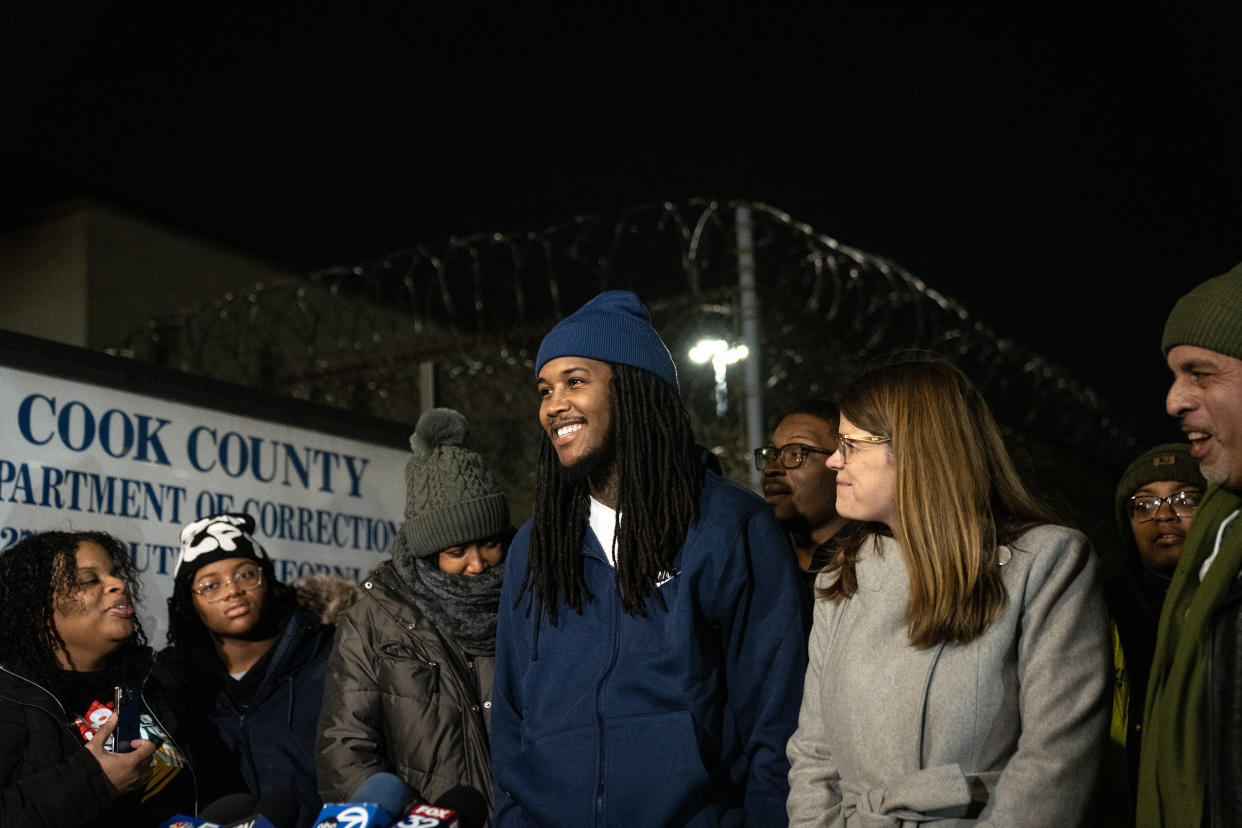Freed after 12 years in prison, man sues city and Chicago police officers over murder investigation

A recently freed man who spent more than 12 years in prison for a fatal South Side shooting in which a legally blind witness identified him as the perpetrator is suing the city of Chicago and several police officers over their handling of the murder investigation.
Darien Harris is seeking compensation in a federal civil rights lawsuit that alleges authorities framed him despite evidence of his innocence. He also is due Thursday in Cook County court, where prosecutors are expected to announce whether they oppose the 31-year-old man’s request for a certificate of innocence.
Harris was an 18-year-old Chicago high school senior near graduation and with a clean criminal record when police arrested him in an ambush-style attack at a gas station that left one man dead and another seriously injured in 2011.
A judge convicted Harris in 2014 of first-degree murder, attempted first-degree murder and aggravated battery with a firearm. After serving more than 12 years of a 76-year prison term, he won his release in December when a judge vacated his convictions and prosecutors dropped all charges.
Harris received his GED, worked jobs and completed other educational programs while incarcerated. In a recent telephone interview, he told the Tribune he’s enjoyed spending time with family since his release but continues to struggle while “trying to get my life together.”
“I don’t have any financial help. I’m still (treated like) a felon so I can’t get a good job. It’s hard for me to get into school,” he said. “I’ve been so lost. … I feel like they took a piece of me that is hard for me to get back.”
The federal complaint alleges Harris’ conviction was the result of “egregious misconduct” by police who “fabricated evidence, including false witness statements and identifications through such tactics as coercion, threats, fact-feeding, and promises of leniency.” It argues Harris’ wrongful conviction was not “an isolated incident” but rather “part of patterns and practices of systemic police misconduct” at Area 2 headquarters.
Authorities lacked physical evidence linking Harris to the shooting, but the judge at the bench trial said that he based his ruling primarily on the testimony of Dexter Saffold, a man who picked Harris out of a police lineup and identified him in court.
The judge was unaware during the trial that Saffold was legally blind because of glaucoma, court records show. In winning Harris his freedom last year, attorney Lauren Myerscough-Mueller successfully argued that he was wrongfully convicted based on Saffold’s mistaken eyewitness testimony as well as police misconduct.
Saffold testified in 2014 that he was riding his motorized scooter north on Stony Island Avenue near the gas station on June 7, 2011, when he heard gunshots and saw someone about 18 feet away who was aiming a handgun at a person near a car with its hood up. He also said the shooter bumped into him while running away, nearly dropping the gun while trying to put it into a pocket.
Saffold’s eyesight came up only briefly during the trial. Harris’ original attorney asked Saffold if his diabetes affected his vision. He replied yes, then paused and denied that he had vision problems.
But Saffold’s doctor had deemed him legally blind some nine years before the slaying, court records show. In more recent years, Harris’ lawyers cited medical records dating to 2002 that Saffold had publicly filed in various lawsuits regarding his disability. An ophthalmologist also offered his expert opinion that Saffold was legally blind “for years leading up to the crime.”
Faced with the new evidence, prosecutors last year did not fight Harris’ release. They declined to comment on whether they will object to his recent request for a certificate of innocence, which will help Harris expunge his record.
The victim in the shooting, 23-year-old Rondell Moore, had pulled into a gas station in Woodlawn because of car troubles. He put up the car’s hood to inspect the problem, assisted by a local mechanic. Moore’s older brother and a friend also were there.
The station’s surveillance system did not capture the shooting, but prosecutors said the video did show an individual walking away from a black Lexus and around the gas station toward the area where the shooting occurred, then running away shortly afterward. The video showed a man whose thin build and short hairstyle generally fit Harris, but the suspect’s face was not visible.
Moore, who was shot three times, ran from the gas station and died in a nearby parking lot. The mechanic survived bullet wounds to his back and an arm.
Though prosecutors previously maintained they had credible evidence from other eyewitnesses that pointed to Harris’ guilt, the federal lawsuit alleges police misconduct played a role in those identifications.
The alleged getaway driver, who has since died, took the stand during Harris’ trial and recanted his initial identification of Harris. He said Harris was never in his car and police officers coerced him into making a false identification, according to court records and the lawsuit. Police detectives denied at the 2014 trial that they pressured the man to identify Harris.
Harris’ lawyers have argued that the actual offender was a teenager who was killed several months later in another Chicago shooting. An employee of the gas station has identified that man — not Harris — as the shooter, according to the lawsuit, filed last month by Loevy & Loevy attorney Quinn Rallins. The employee, who did not testify at Harris’ 2014 trial, alleges that police tried to coerce him into making a false identification.
A spokesperson with the city’s Law Department did not respond to a request for comment Friday.

